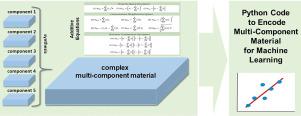MixtureMetrics: A comprehensive package to develop additive numerical features to describe complex materials for machine learning modeling
IF 2.4
4区 计算机科学
Q2 COMPUTER SCIENCE, SOFTWARE ENGINEERING
引用次数: 0
Abstract
Multi-component materials/compounds and polymeric/composite systems pose structural complexity that challenges the conventional methods of molecular representation in cheminformatics, which have limited applicability in such cases. Therefore, we have introduced an innovative structural representation technique tailored for complex materials. We implemented different mixing rules based on linear and nonlinear relationships’ additive effect of different components in composites treating each multi-component material as a mixture system. We developed and improved mixture descriptors based on 12 different mixture functions grouped into three main categories: property-based descriptors, concentration-weighted descriptors, and deviation-combination descriptors. A python package was developed for this purpose, allowing users to compute 12 different mixture-descriptors to use as input for the generation of mixture-based Quantitative Structure-Activity/Property Relationship (mxb-QSAR/QSPR) machine learning models for predicting a range of chemical and physical properties across various complex systems.

MixtureMetrics:一个综合软件包,用于开发描述复杂材料的加法数值特征,以进行机器学习建模
多组分材料/化合物和聚合物/复合材料系统结构复杂,对化学信息学中的传统分子表示方法提出了挑战,因为这些方法在此类情况下的适用性有限。因此,我们针对复杂材料引入了一种创新的结构表示技术。我们根据复合材料中不同成分的线性和非线性关系'相加效应'实施了不同的混合规则,将每种多成分材料视为一个混合物系统。我们根据 12 种不同的混合物函数开发并改进了混合物描述符,主要分为三类:基于属性的描述符、浓度加权描述符和偏差组合描述符。为此,我们开发了一个 python 软件包,允许用户计算 12 种不同的混合物描述符,作为生成基于混合物的定量结构-活性/性质关系(mxb-QSAR/QSPR)机器学习模型的输入,用于预测各种复杂系统的一系列化学和物理性质。
本文章由计算机程序翻译,如有差异,请以英文原文为准。
求助全文
约1分钟内获得全文
求助全文
来源期刊

SoftwareX
COMPUTER SCIENCE, SOFTWARE ENGINEERING-
CiteScore
5.50
自引率
2.90%
发文量
184
审稿时长
9 weeks
期刊介绍:
SoftwareX aims to acknowledge the impact of software on today''s research practice, and on new scientific discoveries in almost all research domains. SoftwareX also aims to stress the importance of the software developers who are, in part, responsible for this impact. To this end, SoftwareX aims to support publication of research software in such a way that: The software is given a stamp of scientific relevance, and provided with a peer-reviewed recognition of scientific impact; The software developers are given the credits they deserve; The software is citable, allowing traditional metrics of scientific excellence to apply; The academic career paths of software developers are supported rather than hindered; The software is publicly available for inspection, validation, and re-use. Above all, SoftwareX aims to inform researchers about software applications, tools and libraries with a (proven) potential to impact the process of scientific discovery in various domains. The journal is multidisciplinary and accepts submissions from within and across subject domains such as those represented within the broad thematic areas below: Mathematical and Physical Sciences; Environmental Sciences; Medical and Biological Sciences; Humanities, Arts and Social Sciences. Originating from these broad thematic areas, the journal also welcomes submissions of software that works in cross cutting thematic areas, such as citizen science, cybersecurity, digital economy, energy, global resource stewardship, health and wellbeing, etcetera. SoftwareX specifically aims to accept submissions representing domain-independent software that may impact more than one research domain.
 求助内容:
求助内容: 应助结果提醒方式:
应助结果提醒方式:


